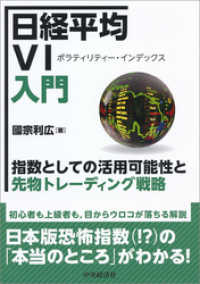- ホーム
- > 洋書
- > 英文書
- > Politics / International Relations
Full Description
Rwanda and Burundi are strikingly similar countries that underwent democratization in the early 1990s. In both, resistance to democratic reforms led to coups d'état and presidential assassinations. A conundrum arises in terms of what transpires next. In Rwanda, total genocide was perpetrated by extremist Hutu actors, including government officials, upon the country's Tutsi and politically moderate Hutu populations. In Burundi the coup d'état failed and instead ushered in a lengthy period of civil war. This divergence in outcome is puzzling given the similarity of these two countries, and it is not adequately explained by studies that address collective violence in each.
This book utilizes an integrative approach that facilitates the formation of an explanation that more fully accounts for variation in the type of collective violence that occurred in Rwanda and Burundi. Showing that political actors - during periods of major institutional change - do not all respond to or perceive reform in the exact same manner or in a necessarily rational manner, this book makes an important contribution to the literature on ethnic conflict, collective violence and democratization in Africa.
Contents
Introduction: The Puzzle
Chapter 1: Extant Explanations of Collective Violence in Rwanda and Burundi
Chapter 2: An Alternative Explanation of Collective Violence
Chapter 3: Methodology and Research Design
Chapter 4: A Story of Twins
Chapter 5: Social Structures and Collective Violence in Rwanda and Burundi
Chapter 6: Traditional Political Institutions and Collective Violence in Rwanda and Burundi
Chapter 7: Reference Points, Decision Frames and the Choice to Perpetrate Genocide
Chapter 8: Conclusions
Afterward
-

- 電子書籍
- 転校先の清楚可憐な美少女が、昔男子と思…
-

- 電子書籍
- 日経平均VI入門
-

- 電子書籍
- ダジャレでおぼえる漢字とことば 小学5…
-

- 電子書籍
- 伏 少女とケモノの烈花譚 4巻 ビッグ…
-

- 電子書籍
- NARUTO―ナルト― モノクロ版 6…



